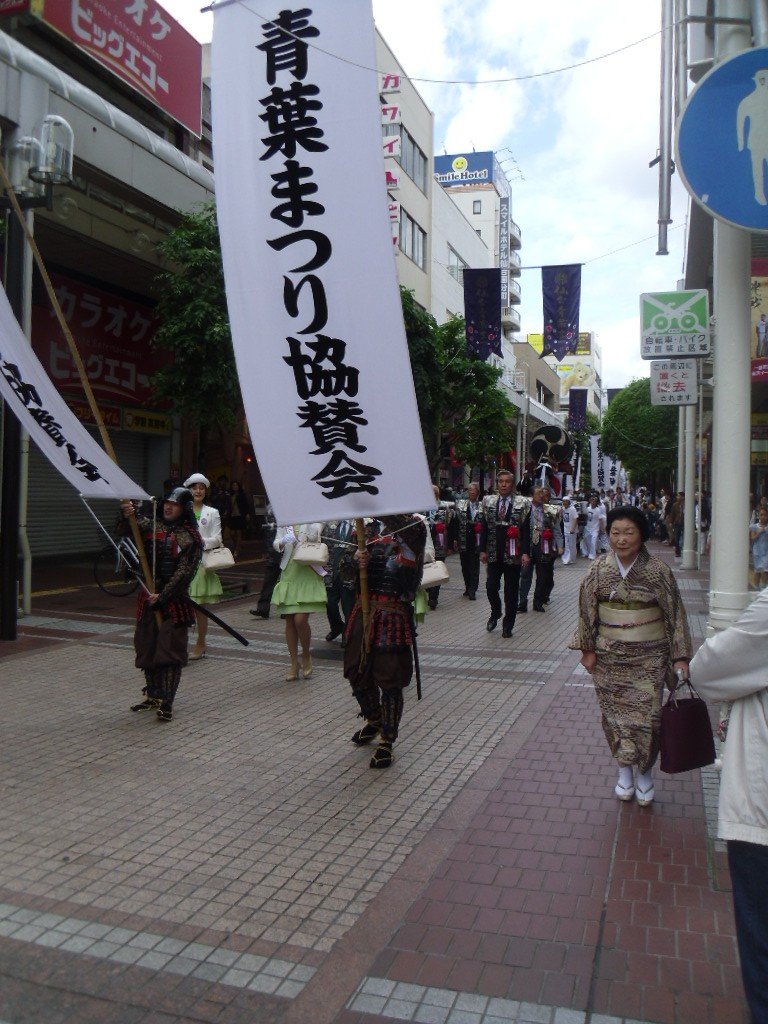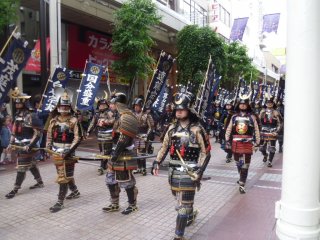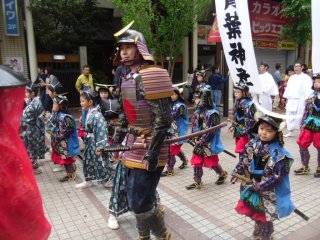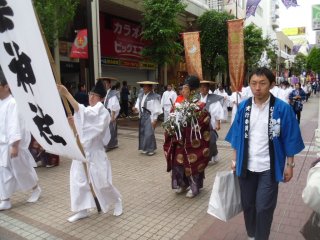
The crest on a samurai's helmet can symbolise many things, from family to animals. One of the banners reads "Kokubun Morishige", who was Date Masamune's uncle.

The first part of the parade begins, with local dignitaries at the head.
![The first part of the parade is much less crowded, so you can see and hear everything. It can get a bit loud, but a drum like this really sets the atmosphere!]()
The first part of the parade is much less crowded, so you can see and hear everything. It can get a bit loud, but a drum like this really sets the atmosphere!
![There are many wonderful costumes in the parade, including these young noblewomen. Their male counterparts are dressed as Sendai's founder, Date Masamune.]()
There are many wonderful costumes in the parade, including these young noblewomen. Their male counterparts are dressed as Sendai's founder, Date Masamune.
![The costumes are really amazing to look at, but you don't get long before they've passed by!]()
The costumes are really amazing to look at, but you don't get long before they've passed by!
![There are Shinto priests as well as samurai, no doubt blessing the occasion.]()
There are Shinto priests as well as samurai, no doubt blessing the occasion.
![Many of the banners are beautiful, such as these from Aoba Shrine. Aoba festival has long been linked with Aoba Shrine.]()
Many of the banners are beautiful, such as these from Aoba Shrine. Aoba festival has long been linked with Aoba Shrine.
![This is Sarutahiko Okami, a deity of the Shinto religion and a symbol of strength and guidance. He is wearing traditional Japanese wooden sandals called geta.]()
This is Sarutahiko Okami, a deity of the Shinto religion and a symbol of strength and guidance. He is wearing traditional Japanese wooden sandals called geta.
![The sounds of gongs and drums are often used in Shinto purification rituals.]()
The sounds of gongs and drums are often used in Shinto purification rituals.
![Some priests carry a mikoshi, a means of transporting a Shinto deity and also a sort of portable shrine. White is a color of purity and the masks are to avoid polluting the air with their breath.]()
Some priests carry a mikoshi, a means of transporting a Shinto deity and also a sort of portable shrine. White is a color of purity and the masks are to avoid polluting the air with their breath.
![A senior priest is protected from the elements by a wagasa, a type of umbrella.]()
A senior priest is protected from the elements by a wagasa, a type of umbrella.
![After the priests, the parade becomes more military as samurai soldiers file past with their various weaponry.]()
After the priests, the parade becomes more military as samurai soldiers file past with their various weaponry.
![These ladies are wearing mushi no tareginu veils.]()
These ladies are wearing mushi no tareginu veils.
![In the red armor with the impressive horns is Sanada Yukimura. He fought on the opposing side to Date Masamune at the Siege of Osaka.]()
In the red armor with the impressive horns is Sanada Yukimura. He fought on the opposing side to Date Masamune at the Siege of Osaka.
![He looks like he means business.]()
He looks like he means business.
![Following behind is Sendai's founder, Date Masamune! He is often at events, sometimes with the rest of his group, the Date Bushoutai.]()
Following behind is Sendai's founder, Date Masamune! He is often at events, sometimes with the rest of his group, the Date Bushoutai.
![Later, the parade grows and takes to the road, with the dignitaries back in the lead. It lasts for over three hours.]()
Later, the parade grows and takes to the road, with the dignitaries back in the lead. It lasts for over three hours.
![Suzume Odori (sparrow dance) dancers are one of the main parts of the parade.]()
Suzume Odori (sparrow dance) dancers are one of the main parts of the parade.
![The other main part of the parade are the giant wheeled floats, called Yamaboko, sponsored by various companies and organizations in Sendai. Each one is uniquely decorated and is pulled by a team of people.]()
The other main part of the parade are the giant wheeled floats, called Yamaboko, sponsored by various companies and organizations in Sendai. Each one is uniquely decorated and is pulled by a team of people.
![This float is graced by the seven lucky gods, who bring health, wealth, happiness, long life and more.]()
This float is graced by the seven lucky gods, who bring health, wealth, happiness, long life and more.
![Different Suzume Odori groups have their own variation on the dance, and different costumes and fans.]()
Different Suzume Odori groups have their own variation on the dance, and different costumes and fans.
![Other styles of dance were also featured, like this one between partners.]()
Other styles of dance were also featured, like this one between partners.
![These female dancers provided their own accompaniment, with brightly ringing bells.]()
These female dancers provided their own accompaniment, with brightly ringing bells.
![The parade route had crowds several people deep, but this samurai on horseback was easy to spot.]()
The parade route had crowds several people deep, but this samurai on horseback was easy to spot.
![Miyajima shrine had this offering for the parade. The two behemoths were carried by a team of people each, and could lower their heads over a surprised crowd!]()
Miyajima shrine had this offering for the parade. The two behemoths were carried by a team of people each, and could lower their heads over a surprised crowd!
![This ship feels like an obvious reference to Date Masamune's diplomatic efforts in Europe.]()
This ship feels like an obvious reference to Date Masamune's diplomatic efforts in Europe.












































































